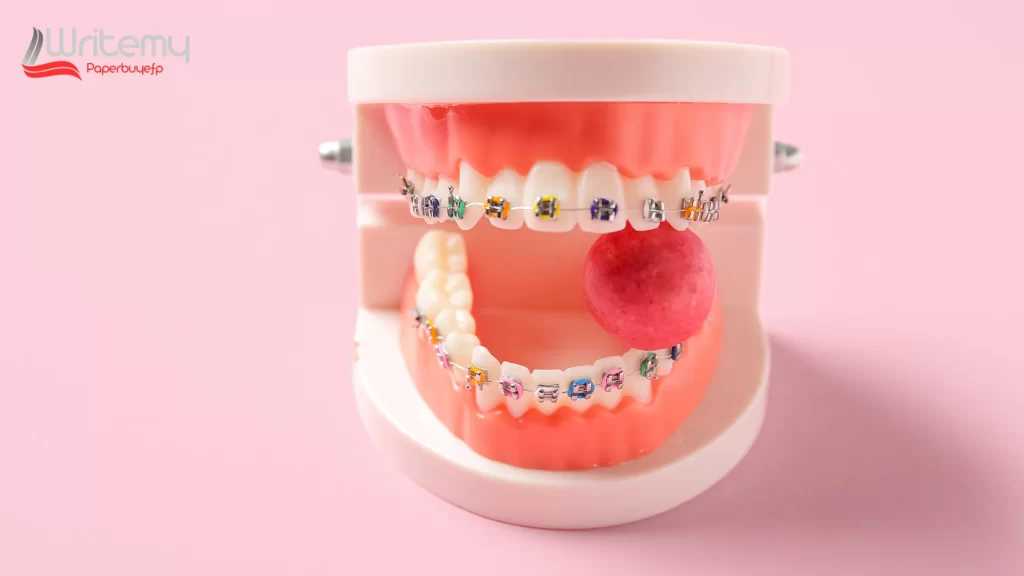Table of Contents
Wearing braces can take some time to get used to, and patients often wonder about the daily habits they might need to change. One of the most common questions is: Can you chew gum with braces? While braces work to straighten your teeth, you might feel uncertain about chewing gum. Fortunately, orthodontists have shared their expert advice on the matter. This article provides a detailed look into whether it’s safe to chew gum, which types are allowed, and how to protect your dental health during your orthodontic treatment.
What Happens When You Chew Gum With Braces?

Can you chew gum with braces, mainly traditional chewing gums? When you chew gum with braces, you might encounter some challenges. The gummy conventional gum texture can easily stick to your orthodontic appliances, such as brackets and wires. This can cause the braces to become loose, leading to damage and possibly slowing down your treatment. Chewing gum with braces can pose various risks, especially if you’re using problematic gum types like sugary or hard gums.
Sticky gums can damage orthodontic appliances, while hard gums can break gum wires, making orthodontic visits necessary for repairs. Orthodontic patients must be careful, as gum problems could lengthen the time spent wearing braces. In particular, sugary gum can increase tooth decay risk, as sugar feeds oral bacteria that create acids, leading to enamel erosion and dental decay.
Also Read: How Much Does LASIK Eye Surgery Cost? Discover the Shocking Truth
Is It Ever Safe to Chew Gum With Braces?
So, can you chew gum with braces safely? Orthodontists say that patients with traditional braces can chew gum—but only the right kind. Sugar-free gum varieties are often the safest choice for braces wearers. Sugar-free gums, especially those with sorbitol or xylitol, are gentle on your enamel and won’t cause damage to your orthodontic appliances. Xylitol also helps protect against tooth decay by reducing bacteria and plaque buildup, making it an excellent option for orthodontic needs.
When selecting sugar-free gum flavors, focus on ones that don’t have a sticky or gummy texture. Some examples include popular brands like Dentyne Ice and over-the-counter gum with a soft texture, which is safe for orthodontic appliances. Chewing gum with a smooth texture and free gum varieties won’t stick to braces, reducing the risk of damage or gum residue getting caught in wires.
Types of Gum to Avoid When Wearing Braces

Although you may wonder if you can chew gum with braces, knowing which types to avoid is essential. There are certain types of gum you should altogether avoid when you have braces:
- Sugary Gum: Sugary gums promote enamel erosion and increase the risk of tooth decay. If sugary gum sticks to your braces, it can cause cavities, which might require additional dental work to fix.
- Sticky Gums: Gums with a sticky or gummy texture, even sugar-free ones, should be avoided. These can get stuck in your braces and require dental tools, increasing the chances of damaging braces.
- Hard Gum: Avoid hard gums that require aggressive chewing. Hard gum can break gum wires, brackets, and even durable brackets, forcing orthodontic appointments for repairs.
If you accidentally chew these types of gum, it’s important to stop immediately and clean your braces thoroughly using dental tools like an orthodontic toothbrush or dental pick. Removing gum residue immediately helps prevent enamel damage and orthodontic care interruptions.
Also Read: How Long Does LASIK Take? Discover the Fast Path to Clear Vision
Expert Tips for Chewing Gum Safely With Braces
If you’re determined to enjoy gum during your orthodontic treatment, orthodontists have shared some helpful tips to make it safer for your braces:
- Choose Sugar-Free Gums with Xylitol: Orthodontists highly recommend sugar-free gums with xylitol, such as Dentyne. They help reduce the risk of tooth decay and protect enamel from erosion. Free gum with xylitol has a soft texture and does not stick to orthodontic appliances, keeping your braces safe.
- Chew Gently: Engage in gentle chewing, as excessive chewing can damage your braces. Constant chewing motion may weaken your brackets or wires, leading to orthodontic adjustments and extending treatment time. Soft, gentle chewing minimizes pressure on your braces.
- Clean Your Braces Thoroughly: After chewing gum, especially if you feel any gum residue left behind, clean your braces with proper oral hygiene practices. Use an orthodontic toothbrush, toothpaste, and flossers to reach between brackets and remove gum particles.
- Limit Chewing Time: Avoid chewing gum all day. Chewing for short periods is fine, but constant chewing motion can weaken your orthodontic appliances over time.
The Benefits of Chewing Sugar-Free Gum With Braces
Now that we’ve answered the question, can you chew gum with braces? You might be surprised to learn that chewing sugar-free gum with braces offers some benefits. Here’s how chewing sugar-free gum can help:
- Increased Saliva Production: Chewing gum boosts saliva production and salivary flow, which helps wash away acids and food particles, protecting your teeth from enamel erosion. This saliva flow is crucial for avoiding dry mouth and reducing the risk of tooth decay.
- Freshens Breath: Chewing sugar-free gum flavors like Dentyne Ice keeps your breath fresh throughout the day. Maintaining fresh breath is an important part of dental health while you wear braces.
- Relieves Orthodontic Soreness: Orthodontic patients sometimes experience soreness after adjustments. Gentle chewing of sugar-free gum can relieve soreness and help your mouth adapt to the new braces.
- Prevents Plaque Buildup: Sugar-free gums like Dentyne Ice with xylitol reduce plaque buildup and promote dental health.
What to Do If Gum Gets Stuck in Your Braces
Even when you’re careful, gum can still get stuck in your braces. If that happens, don’t worry. Here’s what you should do:
- Stop Chewing: As soon as you notice the gum stuck in your braces, stop chewing immediately to avoid further damage to your brackets.
- Rinse With Water: Swish water around your mouth to loosen any gum residue from the braces.
- Use Orthodontic Dental Tools: Use orthodontic flossers, dental cleaners, or an interdental brush to remove any remaining pieces of gum. Be careful to avoid damaging your braces.
- Brush Your Teeth and Braces: Once the gum is removed, brush your teeth thoroughly with fluoride toothpaste to remove any leftover particles.
If the gum won’t come out or you’re concerned about damage, contact your orthodontist for advice.
Also Read: Can You Chew Gum With Braces? Orthodontists’ Expert Advice
Alternatives to Chewing Gum With Braces
If you’re still hesitant about whether you can chew gum with braces, there are plenty of alternatives to keep your mouth fresh and avoid gum problems:
- Sugar-Free Breath Mints: These are great for freshening your breath and are braces-friendly options. Choose sugar-free breath sprays or mints that dissolve quickly.
- Orthodontic Wax: If you’re feeling discomfort, orthodontic wax can be applied to brackets to protect your gums without the need to chew.
- Mouthwash and Hydration: Using mouthwash daily and drinking water regularly helps maintain good oral hygiene. Hydration keeps your mouth fresh and prevents dry mouth, a common side effect of wearing braces.

